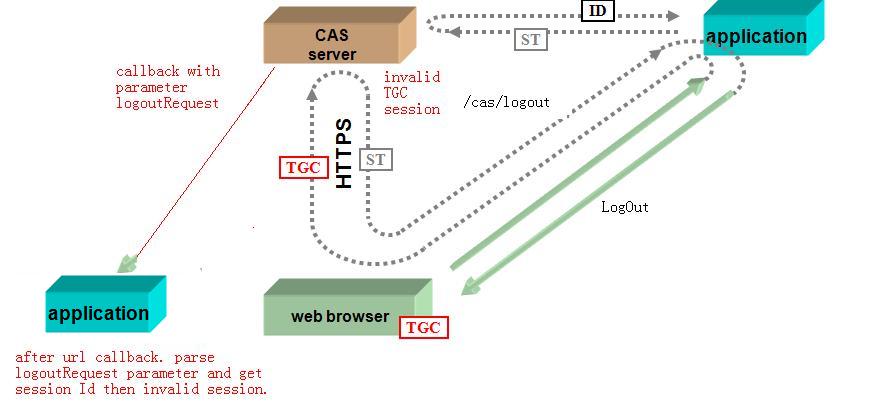ok,现在开始本文的重点内容讲解,先来了解一下cas 实现single sign out的原理,如图所示:


第一张图演示了单点登陆的工作原理。
第二张图演示了单点登出的工作原理。
从第一张图中,当一个web浏览器登录到应用服务器时,应用服务器(application)会检测用户的session,如果没有session,则应用服务器会把url跳转到CASserver上,要求用户登录,用户登录成功后,CASserver会记请求的application的url和该用户的sessionId(在应用服务器跳转url时,通过参数传给CASserver)。此时在CAS服务器会种下TGC Cookie值到webbrowser.拥有该TGCCookie的webbrowser可以无需登录进入所有建立sso服务的应用服务器application。
在第二张图中,当一个web浏览器要求登退应用服务器,应用服务器(application)会把url跳转到CAS server上的/cas/logout url资源上,
CAS server接受请求后,会检测用户的TCG Cookie,把对应的session清除,同时会找到所有通过该TGCsso登录的应用服务器URL提交请求,所有的回调请求中,包含一个参数logoutRequest,内容格式如下:
<samlp:LogoutRequest ID]" Version ="2.0" IssueInstant ="[CURRENT DATE/TIME]" >
<saml:NameID>@NOT_USED@</saml:NameID>
<samlp:SessionIndex>[SESSIONIDENTIFIER] </samlp:SessionIndex>
</samlp:LogoutRequest>
<saml:NameID>@NOT_USED@</saml:NameID>
<samlp:SessionIndex>[SESSION
</samlp:LogoutRequest>
所有收到请求的应用服务器application会解析这个参数,取得sessionId,根据这个Id取得session后,把session删除。
这样就实现单点登出的功能。
知道原理后,下面是结合源代码来讲述一下内部的代码怎么实现的。
首先,要实现single sign out在 应用服务器application端的web.xml要加入以下配置
<filter>
<filter-name>CAS Single Sign Out Filter </filter-name>
<filter-class>org.jasig.cas.client.session.SingleSignOutFilter</filter-class>
</filter>
<filter-mapping>
<filter-name>CAS Single Sign Out Filter </filter-name>
<url-pattern>
31 protected SessionMappingStorage getSessionMappingStorage() {
32 return SingleSignOutFilter.getSessionMappingStorage();
33 }
34 }
</filter>
<filter-mapping>
31
接下来,我们来看一下CAS server端回调是怎么实现的
先来看一下配置,我们知道CASserver所有的用户登录,登出操作,都是由CentralAuthenticationSer
我们就先把到CentralAuthenticationSer
<!-- CentralAuthenticationService -->
<bean vice" class ="org.jasig.cas.CentralAuthenticationServiceImpl"
p:ticketGrantingTicketExpirationPolicy-ref ="grantingTicketExpirationPolicy"
p:serviceTicketExpirationPolicy-ref ="serviceTicketExpirationPolicy"
p:authenticationManager-ref ="authenticationManager"
p:ticketGrantingTicketUniqueTicketIdGenerator-ref ="ticketGrantingTicketUniqueIdGenerator"
p:ticketRegistry-ref ="ticketRegistry"
p:servicesManager-ref ="servicesManager"
p:persistentIdGenerator-ref ="persistentIdGenerator"
p:uniqueTicketIdGeneratorsForService-ref ="uniqueIdGeneratorsMap"
配置使用了spring2.0的xsd。CentralAuthenticationSer
它的key值是所有实现org.jasig.cas.authentication.principal.Service接口的类名,用于保存Principal对象和进行单点登出回调
application server时使用value值为org.jasig.cas.util.DefaultUniqueTicketIdGen
该属性引用的uniqueIdGeneratorsMap bean在uniqueIdGenerators.xml配置文件中。
<util:map
<entry
key="org.jasig.cas.authentication.principal.SimpleWebApplicationServiceImpl"
value-ref ="serviceTicketUniqueIdGenerator"
<entry
key="org.jasig.cas.support.openid.authentication.principal.OpenIdService"
value-ref ="serviceTicketUniqueIdGenerator"
<entry
key="org.jasig.cas.authentication.principal.SamlService"
value-ref ="samlServiceTicketUniqueIdGenerator"
<entry
key="org.jasig.cas.authentication.principal.GoogleAccountsService"
value-ref ="serviceTicketUniqueIdGenerator"
</util:map>
那CentralAuthenticationSer
我们跟踪一下代码,在创建ticket的方法 public StringcreateTicketGrantingTick
可以找到以下这样一段代码:
1 //创建 TicketGrantingTicketImpl 实例
2 final TicketGrantingTicket ticketGrantingTicket = TicketGrantingTicketImpl(
3 this.ticketGrantingTicketUniqueTicketIdGenerator
4 .getNewTicketId(TicketGrantingTicket.PREFIX),
5 authentication, this.ticketGrantingTicketExpirationPolicy);
6 //并把该对象保存到 ticketRegistry中
7 this.ticketRegistry.addTicket(ticketGrantingTicket);
2
7
上面的代码,看到ticketRegistry对象保存了创建的TicketGrantingTicketImpl
事情,代码如下:
10
11
12
14
16
18
20
21
我们看到,它是从ticketRegistry对象中取得TicketGrantingTicket对象后,调用expire方法。接下来,要关心的就是expire方法做什么事情
从代码可以看到,它是遍历每个 Service对象,并执行logOutOfService方法,参数是StringsessionIdentifier
现在我们可以对应中,它存放的Service就是在uniqueIdGeneratorsMap bean定义中的那些实现类
因为logOutOfService方法的实现,所有实现类都是由它们继承的抽象类AbstractWebApplicationSe
AbstractWebApplicationSe
10
13
14
15
17
18
23
至此,已经通过源代码把 CAS实现 single signout的实现原理和方法完整叙述了一遍,希望对CAS感兴趣的朋友有所帮忙,